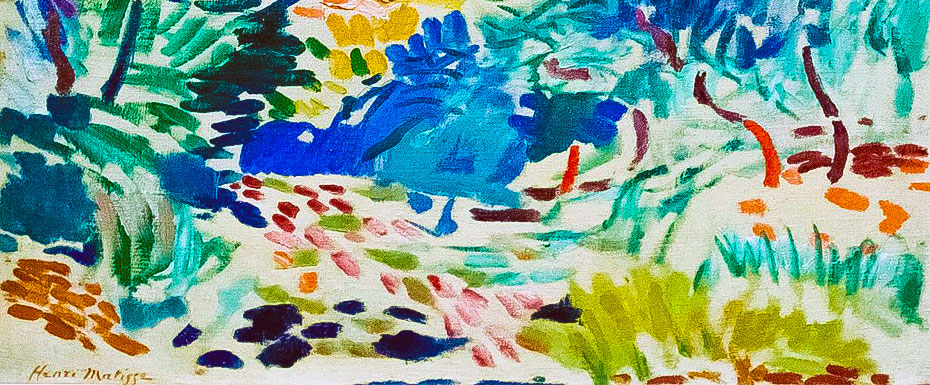
The French artist Henri Matisse is known to the world as a great explorer of color. Even though he came to art at a relatively late age, this did not prevent him from becoming a stunning innovator. Modest, restrained in life, Matisse spilled all his experiences and feelings on canvas: by depicting fewer details, he tried to convey more emotions. This article offers a brief overview of the life and art of Matisse, with a focus on his role in Fauvism, an artistic movement that defined the art of the 20th and 21st centuries.
Late Bloomer
Henri Matisse was born on December 31, 1869, in a small town in the north of France in the family of a ceramist and a successful grain merchant. He was prepared for a great future: Matisse was educated at a prestigious school and then at a lyceum. But the rebel inside Henri existed from an early age: he was not afraid to openly declare to his father that he was not going to continue his work.
Matisse came to art quite late: at first, he studied in Paris to become a lawyer, and upon returning to his hometown, he got a job as a clerk in a law office. However, he did not stay there for a long time: at the age of 20, the young man’s appendicitis worsened, which is why Henri was in the hospital for two months. To keep the son from getting bored, his mother brought him paper and paints. Drawing fascinated him so much that Matisse left jurisprudence and entered an art school upon recovery to the great disappointment of his father.
The acquaintance with John Russell, an Australian artist, became fateful for Matisse. He recalled: “Russell was my teacher. He explained the theory of color to me.” In the works of Matisse of that period, one can already find the influence of the Impressionists and a hint of his own vision – such are his first landscapes – “The Path in the Bois de Boulogne” and “Jardin du Luxembourg”.
Muse

Becoming a husband was an important moment in the development of Matisse as an independent artist. Henri and Amelie met at a friend’s wedding. Amelie was the first to believe in Matisse’s talent and convinced him that he should continue to pursue art and seek his own style. Before the wedding, Matisse confessed to Amelie that although he loves her, he will always love painting more. She accepted this truth, becoming the muse of his life.
Savages
At the Salon d’Automne of 1905, a group of young artists presented their revolutionary paintings to the public. Henri Matisse, André Derain, and Maurice de Vlaminck exhibited their works from a summer trip to Collioure, a fishing village on the Mediterranean. Their paintings exhibited bright, unnatural colors, and oil casually spread across the canvas. The works were met with a flurry of criticism.
The paintings of the Fauves attacked the beholders and forced them to start a dialogue. You couldn’t pretend you didn’t notice them. They did not try to deceive: this impact was absolutely sincere and honest. With their expressive canvases, they challenged the conventionality of perception.
Travels
Matisse adored long trips, which affected his style a lot. Often, a new location inspires artists to make bold decisions and allows them to look at their work from a different angle. This is exactly what his travels to Morocco and Algeria became for him.
Monochrome Paris, with its characteristic intelligent restraint, was replaced by colorful Africa with local culture and customs. The blinding sun added brightness and contrast to the local landscapes and ornate streets.
Last Years
Matisse, who was confined to a wheelchair in 1941 after surgery to remove intestinal cancer, lost the opportunity to work while standing. But this led him to the invention of the decoupage technique.
By cutting out abstract figures of animals, people, plants, Matisse created a series of collages. The works were distinguished by their minimalism and brevity, which caused controversy. The birds, plants, fish – all were childishly arbitrary, but their combination turned all the imperfections into an indivisible piece of art.
The discovery turned out to be innovative and daring – typical for Matisse. As always, the artist shocked everyone with his ingenuity, but he himself was happy that he had finally found the perfect means of expressiveness through color.
In 1948, Matisse was given the opportunity to design the Rosary Chapel, where he used the decoupage technique for decorative purposes. He continued to work until his death in 1954.
Heritage
Matisse’s impact on modern art is almost inconceivable: the expressive forms he discovered surround us everywhere in everyday life. Color palettes and techniques have become entrenched in applied design. Matisse was one of the first to realize the decorative power of painting.
It is amazing how simple the great artist’s idee fixe was: “the simpler the means, the stronger the feeling.” He never stopped looking for ways to simplify form to its natural state. To a keen eye, the art philosophy of Matisse is omnipresent.





